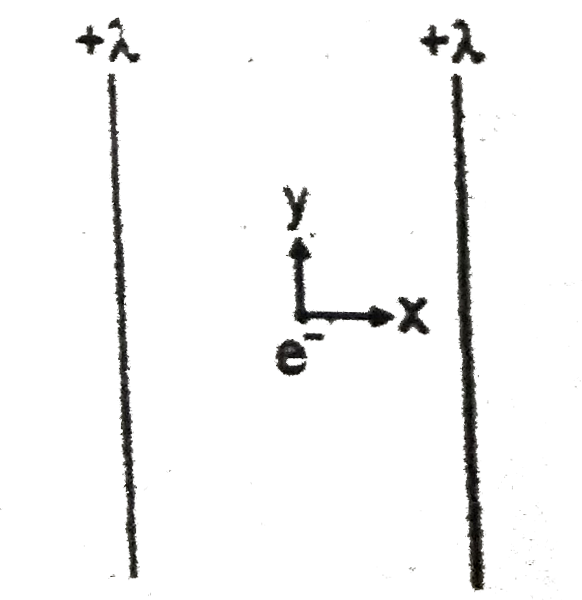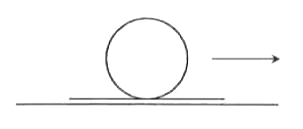Statement 1: While drawing a line on a paper by pencil, friction force acts on paper in the same direction along which line is drawn on the paper. Statement 2: Friction always opposes motion.
Statement-1 is true, Statement-2: is true, Statement-2 is a correct explanation for Statement-1.
Statement-1 is true, Statement-2: is true, Statement-2 is NOT a correct explanation for Statement-1.
Statement-1 is true but statement-2 is false
Statement-1 is false, Statement-2 is true
The correct Answer is:C
Friction always oppose relative motion.
टॉपर्स ने हल किए ये सवाल
समान प्रश्न
A ball of density d is dropped onto a horizontal solid surface. It bounces elastically from the surface and returns to its original position in a time t1. Next, the ball is relasesed and it falls through the same height before striking the surface of a liquid of density dL.
(a) If d<dL, obtain an expression ( in terms of d,t1 and dL) for the time t2 the ball takes to come back to the position from which it was released.
(b) Is the motion of the ball simple harmonic?
(c ) If d=dL how does the speed of the ball depend on its depth inside the liquid? Neglect all frictional and other dissipative force. Assume the depth of the liquid to be large.
View SolutionAn electron is placed just in the middle between two long fixed line charges of charge density +λ each. The wires are in the xy plane (do not consider gravity)

View SolutionStatement 1: While drawing a line on a paper by pencil, friction force acts on paper in the same direction along which line is drawn on the paper. Statement 2: Friction always opposes motion.
View Solution(A) : Force of friction applied by ground on the wheels of a bicycle is always in the direction of motion of the bicycle .
(R) : Force of friction always opposes the relative motion between the surfaces in contact .
View SolutionStatement: Some keys are pencils. All papers are pencil
Conclusion: I All papers are keys
II. No papers are keys
View SolutionFill in the blanks :
A line ____ be drawn on a paper .
View SolutionStatement I : Friction opposes motion of a body.
Statement II : Static friction is self adjusting while kinetic friction is constant.
View SolutionFrictional force always opposes motion of a body.
View SolutionTaking the following statements carefully, select the correct option from the options given below. Statement - 1: When a line is drawn on a paper with a pencil, the frictional force on the paper is along the direction of the drawn line. Statement - 2: Friction always opposes motion
View Solutionएक गेंद टेबल की सतह पर रखे समतल कागज पर विराम में है। चित्रानुसार कागज को क्षैतिजतः तीव्र गति से दांयी ओर खींचा जाता है। टेबल के सापेक्ष इसकी प्रारम्भिक स्थिति से गेंद

(1) सदैव विराम में रहेगी यदि कागज व गेंद के मध्य घर्षण न हो।
(2) बांयी ओर गति करते हुए पीछे की ओर लुढ़कना प्रारम्भ करेगी अर्थात बांयी ओर गतिमान होगी यदि कागज तथा गेंद के मध्य घर्षण हो।
(3) आगे की दिशा में गति करेगी अर्थात् कागज के खींचे जाने की दिशा में। उपरोक्त सही कथन है/हैं
View SolutionStatements: 1. Some papers are pens
2. Some pencils are pens
Conclusions: 1. Some pens are pencils
2. Some pens are papers
View Solutionकथन : घर्षण बल, संपर्क बल का सतह के समांतर घटक होता है।
कारण : घर्षण बल हमेशा वस्तु की गति का विरोध करता है।
View Solutionकथन: वस्तु पर लगने वाला तनाव बल हमेशा वस्तु से दूर लगता है।
कारण: घर्षण बल हमेशा वस्तु की गति का विरोध करता है।
View SolutiondFku-1: When drawing a simple line on a paper with a pen. So the friction forces on the paper work in the same direction in which the pen is moved. dFku-2: Friction always opposes motion.
View Solutionघर्षण सदैव गति का विरोध करता है।
View SolutionState whether the following statement is true or false:
Force of friction always acts in a direction opposite to the direction of motion of the object.
View Solution
